Frogfish are one of the most fascinating and unique marine creatures, known for their extraordinary camouflage abilities, strange appearance, and unusual hunting techniques. These bottom-dwelling fish belong to the family Antennariidae, and they thrive in tropical and subtropical oceans worldwide. Despite their small size, frogfish are incredible predators, using their bodies to blend seamlessly into their surroundings and ambush unsuspecting prey. In this detailed guide, we will explore the habitat, behavior, appearance, and feeding habits of the frogfish, as well as their unique role in the marine ecosystem.
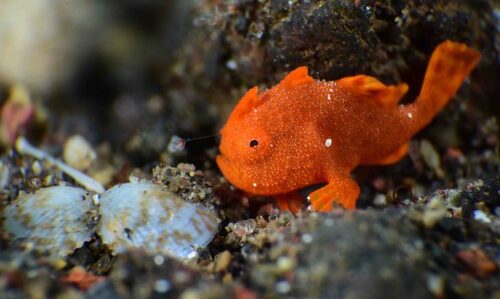
Frogfish are small, stocky fish that are part of the anglerfish order (Lophiiformes). They have a specialized fin, called the illicium, that acts as a lure to attract prey. Unlike most fish, frogfish are poor swimmers. Instead, they use their pectoral fins to “walk” along the seafloor, making them appear more like amphibians than typical fish. This, combined with their ability to change color and texture, makes frogfish one of the ocean’s best ambush predators.
Scientific Family: Antennariidae
Size: Typically 5–15 cm (2–6 inches) but can grow up to 40 cm (16 inches)
Color and Texture: Can vary dramatically; often match their environment
Habitat: Coral reefs, rocky sea floors, and sandy bottom areas in tropical and subtropical waters
Diet: Carnivorous, feeding on small fish, crustaceans, and even other frogfish
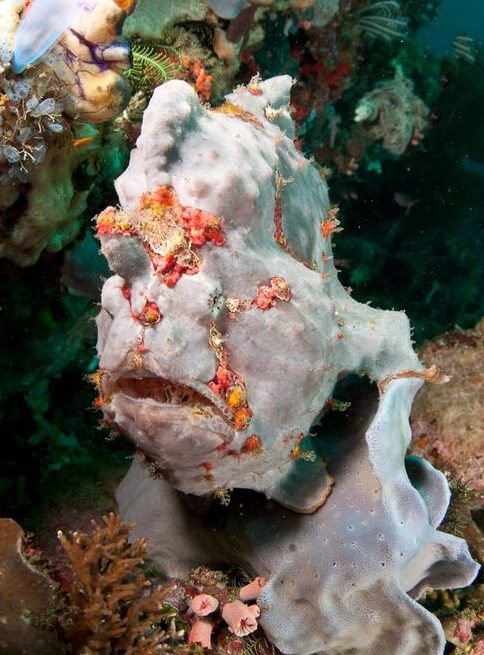
One of the most intriguing aspects of frogfish is their remarkable ability to camouflage. They are often covered with bumps, spines, or other growths, mimicking the appearance of sponges, corals, or rocks. Frogfish can change their color to match their surroundings, a process that can take days or weeks, depending on the species. This ability to blend into their environment makes them nearly invisible to both prey and predators.
Frogfish have short, rounded bodies with a large, upward-facing mouth. Their skin is usually rough or textured, and many species are covered in algae or debris that further enhances their camouflage. They also have a modified dorsal fin, which serves as a lure to attract prey, making them part of the anglerfish family.
Variable Color: Frogfish can be yellow, red, green, white, brown, or a mix of colors, depending on their surroundings. Some species are even able to imitate patterns of coral or sponge.
Texture Adaptation: Their skin may have warts, filaments, or other structures to break up their body outline, making them look like part of the coral reef or seafloor.
Frogfish are primarily found in tropical and subtropical waters around the world. They are most commonly seen on coral reefs, rocky sea floors, or sandy bottoms, where their camouflage can be most effective. Frogfish are usually sedentary, staying in one place for long periods, waiting for prey to pass by.
Frogfish are found in oceans worldwide, including:
Indo-Pacific Region: This is one of the richest areas for frogfish diversity.
Caribbean Sea: Another hotspot for various species of frogfish.
Atlantic Ocean: Although less common, frogfish are also found along the coasts of the Atlantic.
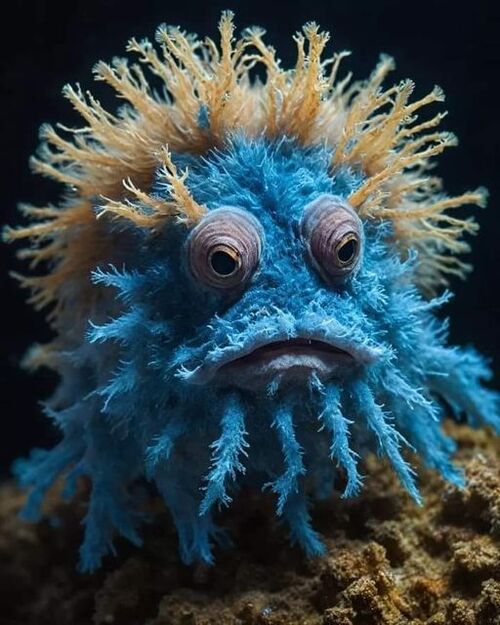
Frogfish are most commonly found in shallow waters, from 1 to 100 meters (3 to 330 feet) deep, but some species live deeper, up to 300 meters (985 feet).
Frogfish are ambush predators. Instead of actively swimming to catch prey, they lie in wait, blending into their surroundings until an unsuspecting fish or crustacean comes too close. Their lure, a fleshy appendage on their head, mimics the appearance of a small fish or worm, attracting curious prey.
Luring Prey: The frogfish waves its illicium (the rod-like fin) with a bait-like structure at the end called the esca. This movement mimics the behavior of small prey, drawing in predators.
Ambush: Once the prey is close enough, the frogfish opens its mouth in a split second, creating a vacuum that sucks the prey inside. This method is incredibly fast, with the entire process taking less than 6 milliseconds.
Feeding: Frogfish swallow their prey whole. Thanks to their large mouths and highly expandable stomachs, they can consume prey up to twice their own size, including other frogfish.
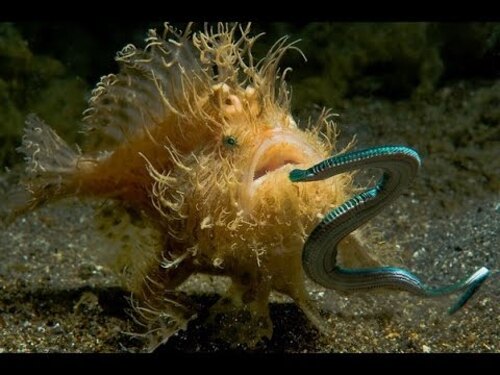
Frogfish are carnivorous and have a broad diet, which typically includes:
Small fish
Crustaceans (such as shrimp and crabs)
Other frogfish (yes, they are sometimes cannibalistic)
Frogfish have an interesting reproductive process, but it can be quite risky, especially for the female. Frogfish are generally solitary creatures, only coming together to mate. The female frogfish will lay eggs, which are then fertilized externally by the male. After fertilization, the female leaves the eggs to develop on their own.
Spawning: When frogfish are ready to mate, the male will nudge the female, and they will swim together briefly.
Egg Production: The female frogfish produces up to 180,000 eggs, which are released in a gelatinous mass known as an egg raft.
Fertilization: The male fertilizes the eggs externally. Once the eggs are fertilized, the pair separates, often with the female moving away quickly to avoid being eaten by the male.
Frogfish eggs hatch into larvae that drift in the planktonic stage before settling on the reef, where they begin their life as benthic (bottom-dwelling) creatures.
While frogfish have excellent camouflage that helps them avoid predators, they are not entirely free from threats. Their natural predators include:
Large predatory fish (such as groupers and moray eels)
Sharks
However, the greatest threat to frogfish today comes from human activity. Habitat destruction, especially coral reef damage, can severely affect frogfish populations. Additionally, frogfish are sometimes collected for the aquarium trade, which can also impact their numbers in the wild.
Frogfish are not currently listed as endangered, but they face increasing pressure from habitat loss and human activity. Protecting coral reefs and marine ecosystems is crucial to ensuring the survival of frogfish populations. Marine protected areas (MPAs) are essential for maintaining healthy frogfish habitats, and efforts to reduce pollution and overfishing also contribute to their conservation.
Fastest Strike in the Animal Kingdom: Frogfish are capable of catching prey in less than 6 milliseconds, one of the fastest capture rates in the animal world.
Cannibalistic Behavior: Frogfish are not picky eaters and will sometimes eat other frogfish, even those of the same species.
Walking Fish: Frogfish use their pectoral fins to "walk" along the ocean floor, a unique feature that adds to their charm.
Incredible Camouflage: Some species can change their color and texture over time to match their surroundings, making them nearly invisible to both predators and prey.
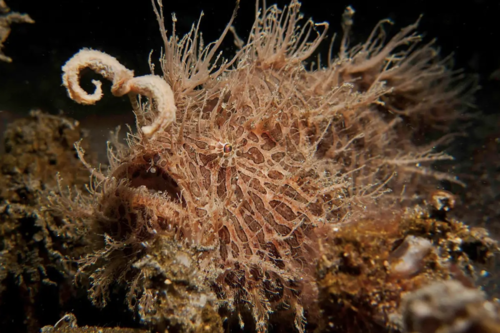
Frogfish are truly one of the ocean’s most unique and intriguing creatures. Their incredible ability to blend into their environment, combined with their lightning-fast hunting techniques, makes them masters of ambush. Although they may be small and slow-moving, frogfish are highly effective predators. As human impact on marine ecosystems grows, understanding and protecting species like the frogfish becomes ever more critical. These fascinating fish serve as a reminder of the ocean’s incredible diversity and the importance of conserving the environments they inhabit.
animal tags: Frogfish
We created this article in conjunction with AI technology, then made sure it was fact-checked and edited by a Animals Top editor.